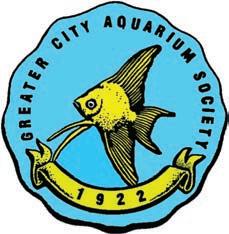July 2023
volume XXX number 5


Our beautiful, classically themed cover photo this month is by Lonnie Goldman. To me it brings to mind some archeological discoveries in the Bay of Naples. Sic transit gloria mundi


July 2023
volume XXX number 5


Our beautiful, classically themed cover photo this month is by Lonnie Goldman. To me it brings to mind some archeological discoveries in the Bay of Naples. Sic transit gloria mundi

Welcome back to another meeting of the Greater City Aquarium Society, and another issue of Modern Aquarium! I think you’ll find that this issue covers a lot of ground (and water) — from German U-boats delivering tropical fish to the U. S. to how fish use their sense of smell to survive in their watery world, to how aeration changed the way we're able to keep our fish alive—to mention just a few!
Our speaker this evening is Dr. Paul Loiselle, who will be discussing ‟The World of Jewel Cichlids.” I’ve been keeping some of these of late, so I’ll certainly be paying attention! I’ve also included in this issue an article from Dr. Loiselle on the catfish Microsynodontis batesi, also known as the African Bumblebee Catfish. See page 9.

After Steve Sica’s article last month on downsizing, I am pleased to report that his article this month is entitled ‟A Little Bit of Upsizing.” Ma non troppo, Steve! Ma non troppo!
We’ve recently had a wealth of articles on various aspects of the history of our hobby, and this issue is no exception. Be sure and see Joe Ferdenzi’s
article, “At the Dawn of Aeration,” on page 12. It’s a pleasure to read, and I must confess that I had never seriously wondered how aeration came to be. I mean, I saw the movies about the parting of the Red Sea, but in my lifetime aerators have just, well, been there! What a treat to find out how they developed! With pictures!
Another historical treat is an exchange article from the September-October 2021 issue of the Missouri Aquarium Society s The Darter. This article, by Thomas M. Keevin and Chuck Bremer, tells us about how, in 1916, a German U-Boat delivered a shipment of tropical fish to (ultimately) St. Louis. It’s a good read! See page 17.
“Sense of Smell in Fishes,” by Alex Bartsch, is sort of a double reprint. It is a pickup from the February 1970 issue of Modern Aquarium, and was originally published in Anchor, the publication of the San Francisco Aquarium Society.

On page 26 you’ll find Dan McKercher’s latest article, “Breeding the Gold/Orange Laser Cory.” On page 27 you’ll find “Pictures From Our Last Meeting” and the June Bowl Show Winners. Congratulations to our winning aquarists and their photogenic fish!

On page 30 our retrospective survey of cover photos continues with front covers from the 2014 issues of Modern Aquarium. The Undergravel Reporter’s submission this month is about dental care for fishes, and is titled “Open Wide.” Who would have thought?! And I just had a crown replaced the other day! I wonder if I could hold my breath long enough for these folks to do it?
The closing Fin Fun puzzle is entitled “Amazing Maze.” Don’t get lost!
March 1
April 6
May 3
June 7
Tom Keegan
Fish Biology 101, Part 1
David Banks
Lake Tanganyika Cichlids and Appropriate Tankmates
Emiliano Spada
Antique Aquariums and Equipment
Karen Randall
Sunken Gardens
July 5 Dr. Paul Loiselle
The Hemichromines: Africa’s Spotted Marauders and Living Flames
August 2
September 6
October 4
November 1
Night At the Auction
Sebastian Alvarado
Color Changes In Fish
William Guo
Freshwater Shrimp
Tom Keegan
Fish Biology 101, Part 2
December 6 Holiday Party!
Articles submitted for consideration in Modern Aquarium (ISSN 2150-0940) must be received no later than the 10th day of the month prior to the month of publication. Please email submissions to gcas@earthlink.net, or fax to (347) 379-4984. Copyright 2023 by the Greater City Aquarium Society Inc., a not-for-profit New York State corporation. All rights reserved. Not-for-profit aquarium societies are hereby granted permission to reproduce articles and illustrations from this publication, unless the article indicates that the copyrights have been retained by the author, and provided reprints indicate source, and that two copies of the publication are sent to the Exchange Editor of this magazine (one copy if sent electronically). For online-only publications, copies may be sent via email to gcas@earthlink.net. Any other reproduction or commercial use of the material in this publication is prohibited without prior express written permission.
The Greater City Aquarium Society meets every month except January and February. Members receive notice of meetings by email and/or by Facebook postings. For more information contact: Dan Radebaugh at (718) 458-8437, email to gcas@earthlink.net, or fax to (347) 379-4984. For more information about our club or to see previous issues of Modern Aquarium, you can also go to our Internet Home Page at http://www.greatercity.net, http://www.greatercity.org, or http://www.greatercity.com.

It’s been another crazy year at Greater City, but attendance at our meetings continues to grow, month by month. A sincere ‟Thank
You” to all of our long-time members, as well as to all our newcomers for your continued tremendous support during the pandemic.
Your welcoming attitude has helped us build and strengthen relationships with both old and new members alike. Our new meeting approach, with Zoom and live speakers makes every meeting exciting!
Our incredible staff (Blow your own horn, Horst!) exceeds even my expectations. That makes us one lucky fish club! We are off to a good start this year! Attendance has grown steadily at our live meetings to the point where we are beginning to approach pre-pandemic numbers. The world has changed, and we are transforming and adapting, while maintaining our values and ideas.
We will certainly have more to come over the rest of this year, and I have no doubt that we have a team of the best members in the aquarium world. It has been a pleasure and an honor to be your president over the past several years, but as I mentioned in this column last month, this will be my last year in that role. It’s time for someone younger than I to take over the reins.
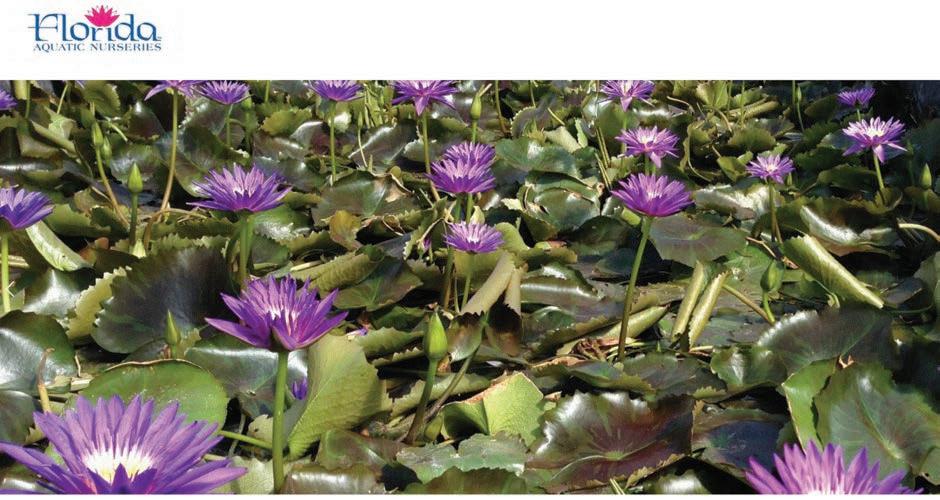
Remember, none of us who are presently on the board were born that way. We became members, found that it was indeed a wonderful club, and have done our part to make it an organization worth belonging to. If you value your membership here and want our club to continue to thrive, by all means ask me or one of the other Board members what you can do to help out. I found that after becoming President I actually enjoyed and appreciated what we do here even more than I did before! Remember, nothing that we do here happens by itself! We need you!

Advanced Marine Aquatics
Al’s Aquatic Services, Inc.

Amazonas Magazine
Aquarium Pharmaceuticals
Aquarium Technology Inc.
Aqueon
Brine Shrimp Direct
Carib Sea
Cobalt Aquatics
Coralife
Ecological Laboratories
Fishworld
Florida Aquatic Nurseries
Franklin Pet Center Inc
Fritz Aquatics
HBH Pet Products
High Quality Exotic Goldfish
Hydor USA
Jehmco
Jungle Bob Enterprises
Jungle Labs
Kent Marine
KHC Aquarium
Kissena Aquarium
Marineland
Microbe Lift
ModernAquarium.com
Monster Aquarium, Inc.
Nature’s Reef & Reptile
NorthFin Premium Fish Food
Ocean Nutrition America
Oceanic
Omega Sea
Pacific Aquarium, Inc.
Penn Plax
Pets Warehouse
Pet Resources
Pisces Pro
Red Sea
Rena
Rolf C. Hagen
San Francisco Bay Brand
Seachem
Sera
Spectrum Brands
Your Fish Stuff.com
Zilla
Zoo Med Laboratories Inc.







Below are photo submissions to our “Fishy Friends” Facebook group. I’ve left the subjects unnamed, but not the photographer. If you see a shot you like, and want more info, ask the photographer about it! I’m sure he or she will be delighted to tell you!

Tonight’s Speaker: July 5, 2023


Dr.Paul V. Loiselle is an enthusiastic aquarist of 50 years’ experience. During the course of his career, Paul has had the opportunity to study cichlids in Madagascar, West Africa, Lakes Victoria and Tanganyika, Haiti, Mexico, Central America and the Peruvian Amazon. Emeritus Curator of Freshwater Fishes at the New York Aquarium and a Senior Conservation Fellow of the Wildlife Conservation Society, he is actively involved in conservation programs focused on the fishes of Madagascar. Paul is co-chair of the I.U.C.N.’s Madagascar Region Freshwater Fish Specialty Group. He serves as a scientific advisor to the Lake Victoria Cichlid Species Survival Program and the Madagascar Faunal Interest Group. A founding member and Fellow of the American Cichlid Association, an honorary fellow of the Association France Cichlid and a life Member of the North Jersey Aquarium Society, he is an internationally published author of numerous articles on the care and breeding of ornamental fishes and such books as The Cichlid Aquarium, Your Garden Pond and The Fishkeeper’s Guide to African Cichlids.
I overheard you say that you’d sell your soul for some of those altums?

 by Denver Lettman
by Denver Lettman
Modern Aquarium has featured cartoon contests before, and theyʼre back! You, the members of Greater City get to choose the caption! Just think of a good caption, then mail, email, or phone the Editor with your caption (phone:347-866-1107, fax: 877-299-0522, email: gcas@ earthlink.net. Your caption needs to reach the Editor by the third Wednesday of this month We'll also hand out copies of this page at the meeting, which you may turn in to Marsha or Dan before leaving. Winning captions will earn ten points in our Author Awards program, qualifying you for participation in our special ”Authors Only” raffle at our Holiday Party and Banquet. Put on your thinking caps!
Your Caption: Your Name:


The upsidedown catfishes of the genus Synodontis are justly popular aquarium residents. These hardy, colorful catfishes have much to recommend them, but as they are decidedly on the robust side, they require sizeable tanks to prosper in captivity. Happily there are a number of mochokid catfishes whose modest adult size makes them ideal candidates for smaller aquaria. Microsynodontis is the most speciose genus of these miniature mochokids, comprising a dozen described species, hailing - with the unique exception of Microsynodontis polli Lambert 1958, native to the upper Niger River - from the coastal rivers of Cameroon, Rio Muni, Gabon and the Republic of Congo as well as the vast Congo basin. As their name implies, these fish look like a
Synodontis seen through the wrong end of a very powerful telescope. While the two genera differ with regard to several skeletal characteristics, they only differ superficially with regard to one feature. Synodontis have a deeply forked caudal fin, whereas in Microsynodontis the shape of this fin can be moderately emarginate, truncate or rounded. A Microsynodontis species was imported into the Netherlands in the 1950ʼs (Baensch, 1997). Whether that species was actually M. batesi is open to question. At that time only a single species of Microsynodontis, M. batesi, was thought to occur in the waters of the Lower Guinean region of West Central Africa. A major revision of the genus (Ng, 2004) has increased the species count for this region from one to nine. Microsynodontis
batesi is native to the basins of the Sanaga, Nyong, Lobé, Ivindo and Campo Rivers in central and southern Cameroon as well as the Ntem River drainage of southern Cameroon and northern Gabon. With the exception of M. hirsuta Ng 2004, which also occurs in the Ntem drainage, all the other Lower Guinean species have been described from material collected in Equatorial Guinea and Gabon. If the fish in this initial importation came from Cameroon, they probably were M.batesi. However, absent precise data on the fishes’ provenance, preserved voucher specimens or a good color photo, the identity of this Microsynodontis will always remain in doubt.
The subject of this month’s article made its appearance on Wet Spot’s price list as “Microsynodontis sp. - African Bumblebee Catfish” early in 2015. I have always felt that Microsynodontis were potentially very desirable aquarium residents and as the price of these African Bumblebee Cats was certainly right, I took the plunge and ordered half a dozen. Thanks to Wet Spot’s customary competent packing, the fish arrived in superb condition. After slow-drip acclimation, they quickly settled into their new quarters. They proved surprisingly photogenic and the resulting images made it possible to establish their identity using the key in Ng’s revision. My African Bumblebee Catfish keyed out to Microsynodontis batesi. The fishes’ Cameroonian provenance, confirmed by a quick phone call to Wet Spot, provided additional confirmation of this identification - M. batesi is the only species of the genus found in that country.

This is an easily maintained catfish. As Microsynodontis batesi is a tropical lowland species, it would be unwise to expose it to temperatures lower than 72̊ F. (24̊ C.). Like other fish hailing from Cameroon, this species prefers soft, slightly acidic water, but it will tolerate neutral to slightly alkaline pH values and hardness values up to 10̊ DH. Like their larger cousins, Microsynodontis are solitary, largely nocturnal catfish. Each individual seeks out a sheltered area to spend
the day. Offered a choice of shelters, my fish have displayed a marked preference for the nooks and crannies offered by pieces of waterlogged wood. The appearance of food immediately brings these diminutive catfish into the open and triggers a bout of frenetic activity. I have never regarded catfish as the sharpest pencils in the piscine box, but the rapidity with which this group of M. batesi has learned to associate my appearance with the arrival of food has obliged a reassessment of my views regarding siluroid learning ability! This fish will readily consume flake and pelletized foods of appropriate size, but frozen bloodworms and live black worms are devoured with particular enthusiasm. My fish share their tank with a group of Puntigrus anchisporus and several pairs of Pachypanchax sakaramyi. As these fish occupy the middle and upper third of the water column, opportunities for interaction with the catfish are restricted to the daily feeding time scrum. I thus cannot say whether M. batesi would display comparable indifference to bottom-living fishes such other catfishes, loaches or as dwarf cichlids. That said, in light of its small adult size - a large M. batesi measures a tad over 2" (5.0 cm) TL - prudence would dictate choosing tankmates of roughly the same size.
Miniature fishes typically compensate for the reduced fecundity consequent upon reduced body size in two ways. The first is to produce small numbers of eggs or live young on a more or less continuous
basis. White clouds, the smaller Corydoras species and Heterandria formosa are familiar practitioners of this strategy. The second is to invest significant effort in protecting a reduced clutch of eggs. Dwarf cichlids, licorice and sparkling gouramis and Phylonemus typus, the Lake Tanganyika mustache catfish deal with size-constrained fecundity in this manner. Which path Microsynodontis follow remains to be determined, for nothing is known of their reproductive behavior. What is known of the reproductive biology of their larger cousins is not particularly helpful to aquarists seeking some insight into how these miniature catfish conjugate the amatory verbs. The genus Synodontis includes egg scatterers, species that care for their eggs and one species that parasitizes mouthbrooding cichlids!
Determining the sex of their fish should not be a problem for prospective breeders of M. batesi. Males of this species, like those of their larger cousins, have a welldeveloped, somewhat penis-shaped genital papilla that can be easily seen using a hand lens. Females are also somewhat larger and markedly plumper in appearance than males. As previously noted, this species is typically solitary in its behavior. However, the largest female of my group and a smaller male
consistently share a shelter. I plan on moving this compatible couple into a well planted five gallon tank and feeding them generously. Time will tell whether this approach to breeding, which has proven successful when applied to miniature Yunnanilus loaches and the moth catfishes of the genus Hara, will also work with M. batesi.
Small, rather secretive species like M. batesi do not show themselves to best advantage in retailers’ tanks and are thus rarely to be found in such a venue. Thus finding this delightful little catfish is likely to prove something of a chal- lenge. For the moment, hobbyists wishing to work with this species are most likely to find it offered for sale by on -line dealers. Regardless of how much effort must be expended in the search, M. batesi will repay it in full!
Literature Cited
Baensch, H. A. 1997. Aquarien Atlas. Band 5. Mergus-Verlag, Melle, pp. 1 - 1148.

Ng, H. H. 2004. The Microsynodontis (Teleostei: Siluriformes: Mochokidae) of the lower Guinea region, west central Africa, with the description of eight new species. Zootaxa 531: 1 - 52.

What did aquarists use before electricity came into widespread use? How did they heat, filter, and aerate their aquariums? A recent presentation by Emiliano Spada of Rome (Italy) answered these questions through a sampling of his amazing collection of pre-electric aquarium paraphernalia. Most of these devices were made by high-end German manufacturers and were of extremely good quality, hence expensive. So what could you do in a more modest way? Filtration was virtually out of the question, and heating was most cumbersome if not downright dangerous. This leaves us with aeration as something that was available to early aquarists on a budget.
In the magazine Science for June 1910 there is a brief article about a home-made aeration device. The author labels it “a simple and economical aquarium aerator.”


He provides an illustration of the device along with a detailed explanation of how it works. He claims that his “apparatus is the best that has yet come to [his] notice as far as simplicity, economy and regularity of delivery of air are concerned.” After examining his drawing (reproduced at lower left), I am not at all sure that it was a simple device. How it works, however, does seem relatively simple. A constant flow of water is introduced into tube “A,” which empties into jar “E,” from which air is then forced via tube “C” into the aquarium, and excess water from jar “E” is expelled via tube “D.” Of course this wastes quite a bit of water, but most likely water was very plentiful and cheap back in 1910.
Curiously, the utility of this device continued well into the electric era. In an advertisement in the magazine Aquatic Life for June 1933, one can see a commercial version of the aerator described above. (See photo of ad.) It is called the Simplex Aerator, and it clearly functions the same way as the 1910 aerator. Its manufacturer claims it will aerate up to twenty aquariums at a cost of “one cent a day.” Again, water was cheap back then, though even at a cent a day for 30 days that would roughly come to about $7 in today’s money. Speaking of which, the advertised price for the device was $7, which
in today’s money translates to approximately $160! Certainly this was not within the price range of the average aquarist.
Moreover, the Simplex Aerator was now in competition with more sophisticated devices. One of these was the K.D.A. Air Pump, which is illustrated in an ad by the famous Aquarium Stock Company in an issue of Aquatic Life from January 1927. Although the K.D.A. was also connected to a water faucet, it was simpler and more efficient.
Of course by the 1930s, the era of electricity was in full swing. In an ad in Aquatic Life from May 1933, one month before the Simplex Aerator ad, we see one of the first electric air pumps made by the firm of Danner & Bergmann, which they called the Supreme Air-Pump. (See the accompanying illustration at the top right.) The descendent of this firm, now simply known as Danner (after one of its founders, Eugene Danner), is still making aquarium products. The Supreme brand was exceedingly popular

when I entered the hobby in the 1960s, and it was attached to all kinds of aquarium products, such as power filters and heaters, and of course air pumps. The very large pumps seen in the 1933 ad would, over time, become smaller, but just as powerful and well-made. Shown below is a photo of an original Danner air pump from the 1950s which shows the similarity of many of the components present in the 1933 model.

The aquarium hobby made great technological strides between 1910 and 1930, a period of only two decades. These advances would make possible the first golden age of the aquarium hobby in the 1930s, and presage all of the wonderful technology we enjoy today.


There is a Bowl Show at every GCAS meeting, except our Night at the Auction/ fleamarket meeting and our Holiday Party and Awards Banquet meeting. Bowl shows are open to all members of GCAS. Rules are as follows:
• Only current GCAS members may enter fish in the Bowl Show.
• There is a limit of 2 entries per member per meeting.
• Unlike some other clubs, every month is an “open” Bowl Show at the GCAS (i.e., there is no “theme,” such as that one month cichlids are judged, the next livebearers, the next anabantoids, etc.).
• Any fish that wins any prize (1st, 2nd, or 3rd) may not be entered again in the same meeting year.
• B.Y.O.B. (Bring Your Own Bowl!) Entrants are responsible for providing suitable containers and suitable water for their fish. These containers must be clear on at least three sides.

• Only one fish per container (i.e., no “pairs”).
• No plants, ornaments, or equipment (filters, airstones, etc.) are allowed in the judging tank (an external mirror, or opaque cards between containers is acceptable, as is a cover that does not obstruct side viewing).
• Points are awarded: 5 points for 1st Place, 3 for 2nd Place, and 1 for 3rd Place.
• Ribbons are awarded: blue for 1st Place, red for 2nd Place, and green for 3rd Place.
• The person with the most points at the end of the meeting season receives the Walter Hubel Bowl Show Champion trophy at the Awards Banquet.
• The decision of the judge(s) is final.
• A running UNOFFICIAL total of the points awarded is printed in Modern Aquarium. Only the tally of points maintained by the Bowl Show Coordinator is official.
• In case of ties:
• 1st Tiebreaker – most 1st Places
• 2nd Tiebreaker – most 2nd Places
• 3rd Tiebreaker – most entries
In my article last month I briefly described how my custom acrylic aquarium sprang a leak and I replaced it with a smaller 8.3 gallon nano-tank that I had mothballed. A month later, I was amusing myself with some online research when I came upon the Petco website. The company was selling 2.5, 5.5 and 10 gallon Aqueon (formerly the All Glass Company)


Story and Photos by Stephen Sica concept to me, and I have no idea how long they have been on the market. The list price of this 10 gallon tank is $54.99. A standard 10 gallon tank with plastic rim around the top has a $24.99 list price. I mention these prices because I haven’t followed prices on tanks for many years, and I am surprised at these new prices even with the pandemic and the rising cost of fuel. I never thought I would see a “standard beginner’s tank” for such an exorbitant price! Of course, possibly I’ve become cheap! Do you recall when there were sales for a dollar a gallon? I also find it ironic that I am upgrading to a 10 gallon tank!
Many years ago, when my family moved from Williamsburg in Brooklyn to Richmond Hill and I was about 9 or 10 years old, my older brother and I purchased two 10 gallon tanks in Cameo Pet Shop on Jamaica Avenue. We purchased our

rimless top tanks for one-half list price. The bottom of these tanks still retains a black plastic rim. I decided to purchase a 10 gallon to slightly upsize and see for myself, first-hand, exactly what their rimless tanks looked like. For accuracy, the tanks are half rimless, unlike true rimless tanks that are all glass. This Aqueon design was a new
fish and supplies at either Cameo or Kresge’s, a Woolworth’s five and dime type store, on Liberty Avenue. We could either walk or ride our bicycles to either store. Kresge’s ultimately became Kmart. Once my brother discovered girls he lost interest in fish, and I switched to chameleons and finally hamsters. I guess that most of us one day do sort of revert to childhood.
I purchased the tank and spent a leisurely afternoon replacing the 8.3 with the 10 gallon. Everything was identically replaced as in the smaller tank, but I did add a small triangular sponge filter for tanks up to 10 gallons to the rear
of the new tank. If you place one or two plants in front of it, the filter becomes almost invisible. I told my mystery snails that they were not going to lose their jobs. They seemed to be pleased, and continue to work hard to assist in filtering.

Now that I had my 7 zebra danios zipping around a new home, I assumed that they were also pleased with the extra space. I know—10 gallons isn’t much for these active fish, but I like to fool myself sometimes.
male and female, for $3.99. I purchased a young male with a blackish head and deep blue body. I added this fish to my aquarium and decided that the livestock was complete, until on another visit I found four lonely harlequin rasboras. Now it’s complete, unless I find another lonely rasbora or two.
A standard 20x10 inch versa top is sized for 10 gallon tanks. With the rear plastic strip attached, there is about a one-half inch space. I find that the water evaporates a bit more quickly. Two transparent plastic cradles extend across the tank width on each end. The glass top sits upon them. When you open and close the lid you must be careful, or you can pull the lid off, or worse, if you do not pay attention to this seemingly easy task. As with the smaller tank that the 10 gallon replaced, I did not add a substrate. A 50 watt heater and small sponge filter complete this project. Just add fish, which I already did, and you are ready to go!
One day Donna, Cordelia, and I were shopping for dog supplies in the local PetSmart. Of course I always peruse the fish department. Recently, I started noticing betta fish are becoming quite popular for fishkeeping on a small scale. I was admiring some of the fancy bettas when the high prices of some fish caught my attention but I did see veiltail bettas, both

Despite the well-known
the tank that house guests see and the only one in the house above the basement. I do enjoy the lightened workload required to maintain a small aquarium. Changing only 2 or 3 gallons of water seems almost enjoyable.

Lamp

on
may
THE GERMAN U-BOAT Deutschland arrived in Baltimore Harbor in 1916 with a shipment of tropical fish bound for St. Louis, Missouri.
S. Chichester Lloyd became a short side-note in the history of World War I when he sponsored a shipment of tropical fish from Germany during the early part of the war, while the United States was still officially neutral.

Lloyd was a prominent figure in the early history of the aquarium hobby in the United States and St. Louis. Originating in Newark, NJ, Lloyd ultimately moved to St Louis, where he was elected president of the National Aquarium Society of America and likely founded the St. Louis Aquarium Society. In later years Lloyd moved on to California, but while in St Louis he was instrumental in early promotion of goldfish there1, and as President of the St. Louis Aquarium Society, was one of the earliest proponents of a public St. Louis City supported aquarium, not to be fulfilled until over a century later.
The fish shipment was transported by a German U-Boat that arrived in Baltimore, Maryland on 10 July 1916 and then transported to St. Louis by express, the fish being carried by an officer aboard the Deutschland, a friend of Lloyd’s.

According to two St. Louis newspapers2,3 (15 & 16 July 1916), the shipment included twenty-two fish that had been brought over from Hamburg, that Lloyd said were forwarded to him by an officer of the undersea boat Deutschland. Twenty of the fish were ‟peacock fish (probably Poecilla guppi)”. Lloyd indicated that the fish were half an inch long and natives of the northern part of South America. He described the peacock fish as ‟pink in color with large "eyes" of a metallic blue color over its body.”
Lloyd noted that the peacock fish population had tripled overnight. These were undoubtedly guppies (Poecilia reticulata). The shipment also

included two zebra fish (Danio rerio). The fish were to be displayed on Monday night (17 July 1916) at the American Hotel, following a banquet of the St. Louis Aquarium Society. Apparently it didn't take much to get the aquarium hobbyist crowd excited in 1916!
The Deutschland4 was built as an unarmed blockade-breaking submarine intended to transport commercial products to the United States and return to Germany with raw materials for the war effort. The United States had not entered World War I and was officially neutral at this time. The submarine was the first of seven U-151 class U-boats built and one of only two used as unarmed cargo submarines. Her sister ship, the Bremen, was lost on its maiden voyage to the United States. Due to the United States entry into WW I, the other five submarine freighters were converted into long-range cruiser submarine (U-Kreuzers), equipped with two 150 mm deck guns.
There is no official mention of the tropical fish being transported on that voyage. On her return trip to Germany the cargo included 341 tons of nickel, 93 tons of tin, and 348 tons of crude rubber (257 tons of which were carried outside the pressure hull) for the German war effort. Her cargo was valued at $17.5 million, several times the submarine’s construction costs. Possibly fish were sent back to Germany in exchange for the fish sent to the U.S., all on the sly.
The Deutschland made only two voyages to the United States. A third voyage, planned for January 1917, was aborted as German-US relations had worsened following the sinking of shipping bound for the United Kingdom, often just outside US territorial waters. The U.S. declared war on Germany on 6 April 1917.
The Deutschland was taken over by the German Imperial Navy on 19 February 1917 and converted into the U-155, part of the U-Kreuzer Flotilla, being fitted with 6 bow torpedo tubes with 18 torpedoes, and two 15 cm SK L/40 naval guns. Her service to Germany included sinking 42 cargo ships (four from the United States) and damaging one, also from the United States.
So, when you are laying awake at night wondering how tropical fish were transported across the globe in the early days of the aquarium hobby, the answer is by cargo ship … and occasionally by submarine!
1/ Post Dispatch Staff Writer, 1916. How the Goldfish Fad Holds St. Louis. St Louis Post Dispatch, April 23, 1916. Reprinted in Darter Volume 46 #3, page 33.
2/ Anonymous. 1916a. Fish Brought to U.S. in U-Boat Received Here. St. Louis Star and Times (St. Louis, MO) 15 July 1916.
3/ Anonymous. 1916b. Fish Deutschland Brought to U.S. to be Seen Here. St. Louis Globe Democrat 16 July 1916.
4/ German submarine Deutschland. (Article Accessed on 9 August 2021). https://en.wikipedia.org/wiki/ German_submarine_Deutschland.
The 22 tropical fish were transported on the Deutschland’s maiden voyage. She carried 750 tons of cargo, including 125 tons of highly soughtafter chemical dyes, medical drugs, gemstones, and diplomatic mail, with her cargo being worth $1.5 million (approximately $36 million today).
5/ Harry R. Burke, Odyssey of a Cowboy from New York whose hobby is aquarium keeping. St. Louis Globe- Democrat · 5 Jun 1927, Sun · Page 97.

Note: Although S. Chichester Lloyd is mentioned in these newspaper articles as their source, for many St. Louis aquarists he may not have been the most recognizable name involved in this early shipment of tropical fish.


At about that same time, otto Beldt, who had already emigrated to St. Louis, was about to become active as a fish and lily breeder. The fish in this article were apparently sourced from hamburg, where otto’s father already owned his own import/export tropical fish business. Substantiation has not been found, but otto may have helped import his own (and eventually widely known) fish breeding and tropical fish wholesale venture that lasted late into the 19th century.
Otto Beldt is still recognized as having a significant impact on the hobby in the region.





If you like history, and you like pets, then this is the place for you. Dedicated to the history of aquarium & pet keeping, The Museum of Aquarium & Pet History includes a huge depository of over 3,000 items all focused on the pet industry. From antique fish bowls, aquariums and cages, to foods, medications, books and advertising signs, we’ve got it all! To learn more about this amazing collection of historical pet artifacts, please visit our website: moaph.org

https://moaph.org/

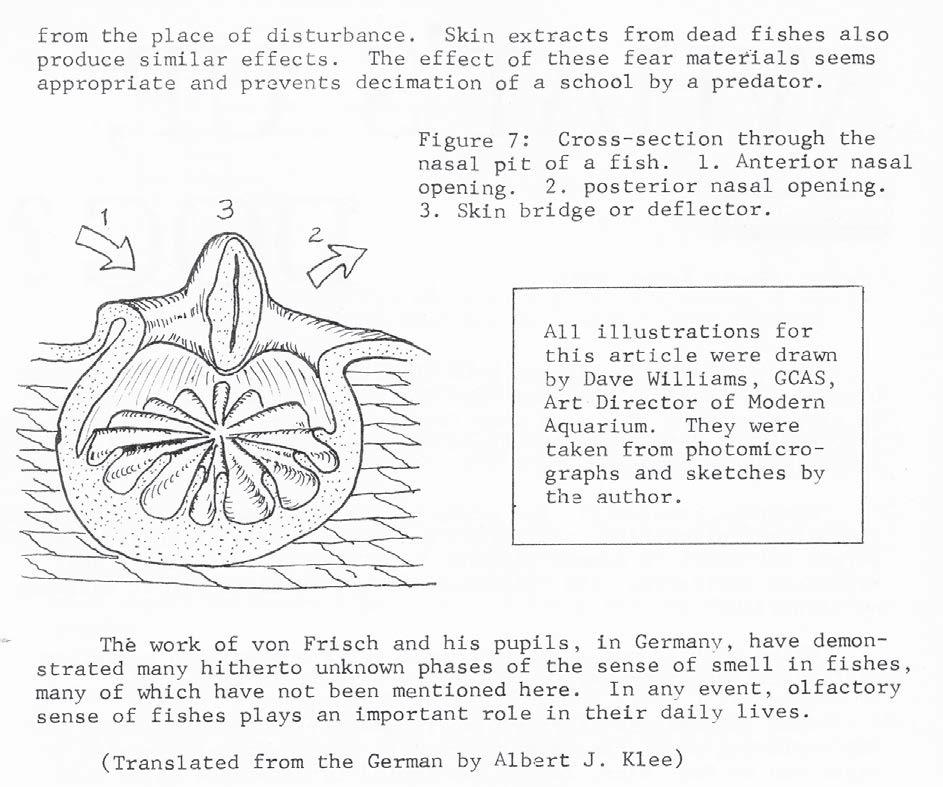
Icame across some gold laser corys a few years ago. Of course I thought it can’t be hard to breed these little fellas. I don’t know many folks that have, but they seem to be the same type as the albino cory. The albino cory just needs water for the most part to get them to breed. So I put 6 of them in a 10 gallon tank with gravel and not much else. I quickly found out that these fish are very shy! All they did was hide under the bubble filter. I had a hard time getting them to eat ANYTHING. I tried bloodworms, flakes, brine shrimp, BBS, microworms, and even Repashy jel. I would end up removing anything I put in the tank. I thought WOW, what a fussy fish! I gave up on trying to feed them anything. I put in a bit of Java moss and oak leaf litter so they could get some natural nourishment.
About two years later I saw some eggs on the glass. Maybe 12 eggs. I got out a razor blade and removed them to an HOB breeder tank, put in a bit of methylene blue and sadly watched all the eggs fail. I did pull the adult fish from the tank and left it without any fish because I didn’t get all the eggs. Some had sunk into the gravel when I tried to scrape them off of the glass. A month or two later I found 2 fry in the tank.
Success!!! The older corys didn’t produce any more eggs. No picture of my 1st fry!

About 9 months went by when I noticed more eggs on the glass. The Java moss had grown enough to take up about 60% of the tank, and the Corys loved to hide in it. They laid most of the eggs on the glass where the Java moss was pressing in between the glass
and the bubble filter. This time I pulled the adults, put in some methylene blue and got about 50 fry. Like their parents, they love to hang out under the bubble filter. I put some baby brine shrimp and microworms in the tanks for the fry. They must have eaten them, because they grew well.
When I put the adults in their new home I put in a load of Java moss and other aquatic plants and placed it in the same manner that they had in their old home, and about 2 weeks later BANG! More eggs! I now have 5 tanks of laser cory fry to tend. The adults are in what may be their final home, laying eggs and letting them hatch, for the most part.
One thing is different with these fry. While they are shy, they do come out in plain sight to eat and play. I remember seeing a video on Youtube from Aquarium Co-op about the orange laser cories: https://www.youtube.com/ watch?v=p-x9SxO6x_Y&t=525s
The author had 20 adult orange laser corys in a 40 gallon tank. While many hung out in the Java moss, the video did reveal that they also happily took advantage of the open spaces, running around and tossing eggs all over the place. As I’m sure many of you know, Corys are a very communal fish, and the more you have in a tank the happier they seem to be. I experienced the same thing that was in the Aquarium C-Op video in my fry tank. It has about 50 fry and around 40 Apistogramma cacatuoides in it. All are getting fat, dumb and happy.



The moral of the story is, if you are considering breeding the gold laser cory,

1. Get a lot of them, and
2. Give them lots of plant cover!

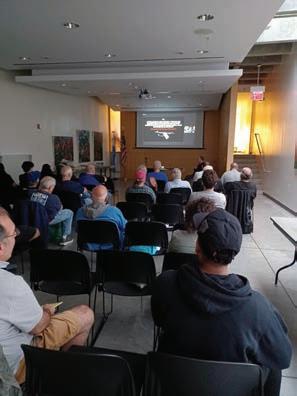


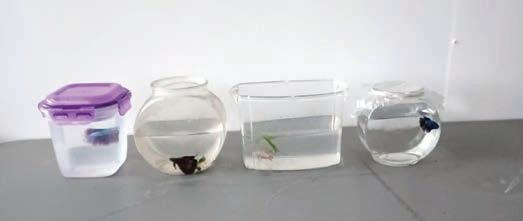





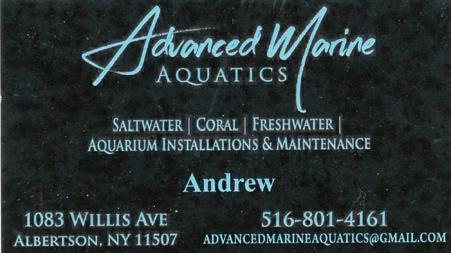







10% Discount on everything.
10% Discount on everything.
10% Discount on everything.
15% Discount on everything in store, or online at: http://www.junglebobaquatics.com Use coupon code gcas15.














March 2014 Rosario, Jean, and Robert LaCorte by Ray Juschkus

April 2014 Betta rutilans by Alexander A. Priest
May 2014 Holacanthus ciliaris by Stephen Sica
June 2014 Lactophrus triqueter by Stephen Sica
July 2014 Goodea atripinnis atripinnis by Alexander A. Priest
August 2014 Sparisoma viride by Stephen Sica
September 2014 Chilomycterus schoepfi by Jeff Bollbach
October 2014 Platies & Guppies by Beth Macht

November 2014 Betta simorum by Alexander A. Priest
December 2014 Pterophylum scalare by Susan Priest


In spite of popular demand to the contrary, this humor and information column continues. As usual, it does NOT necessarily represent the opinions of the Editor, or of the Greater City Aquarium Society

In the event, a diver appears in a white coat, and releases air from a handheld tube. Thinking there is food available, longtooth groupers and other fish swim up and open their mouths. The diver then peers inside their mouths and checks their teeth.
In a recent event, visitors were quizzed with such questions as "Do you know which kind of fish has a tooth structure similar to that of humans?" and children watching the display listened intently. Next to the water tank, the sharp teeth of a blacktip reef shark, and the unique teeth of a spotted eagle ray and of a Japanese bullhead shark were also presented. A panel provided additional information and visitors were allowed to touch the exhibits.
SHIMONOSEKI, Yamaguchi -- A "diving dentist" encouraging fish to open their mouths for checks as visitors learn about their teeth has gained popularity at an aquarium in this western Japan city.
The attraction at the Kaikyokan aquarium in Shimonoseki was timed to coincide with dental and oral health week promoted by the Japan Dental Association from June 4 to 10.

Aquarium display worker Natsuki Shimomura commented, "Fish live in the water so they don't get cavities, but we hope that visitors can discover the mysteries of fish teeth and become more interested in cavity prevention by observing the various kinds here." The 10-minute diving dentist event is held twice a day until June 10.
Reference : https://www.msn.com/en-xl/health/other/diving-dentist-helps-visitors-brush-up-on-fish-toothawareness-at-west-japan-aquarium/ar-AA1ck7Pf#image=1


This month’s puzzle is a straight-forward maze. Have Fun! /

Solution to our last puzzle:
Amazon Sword Echinodorus sp
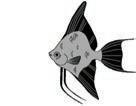
Anacharis Egeria densa
Banana Plant Nymphoides aquatica
Christmas Moss Vesicularia montagnei
Duckweed Lemna minor
Hair Grass Eleocharis montevidensis
Hairgrass Dwarf Eleocharis acicularis
Hornwort Ceratophyllum demersum
Hygro Willow Hygrophila angustifolia
Java Moss Vesicularia dubyana
Java Fern Microsorium pteropus
Micro Sword Liaeopsis brasiliensis
Moneywort Bacopa monnieri
Radican Sword Echinodorus cordifolius
Red Root Floater Phyllanthus fluitans
Wisteria Hygrophila difformis
source: https://www.modernaquarium.com/

